
Kimagro Fishfarming Ltd. (Levantina Fish), a Cypriot aquaculture company specializing in the sustainable cultivation of Mediterranean species such as gilthead sea bream (Sparus aurata), sought to enhance its fish weight monitoring capabilities through non-invasive and scalable technologies. Conventional methods—based on manual sampling—are time-consuming, labor-intensive, and can impose stress on the fish. To address these challenges, Kimagro Fishfarming Ltd. partnered with EuroCC2 Cyprus to investigate automated solutions that leverage Artificial Intelligence, computer vision, and High-Performance Computing (HPC).
Through this collaboration, researchers at the Cyprus Institute developed a portable, cost-effective stereo vision system integrated with a Deep Learning (DL) model for automated fish weight estimation. The system employs a stereo camera to capture RGB images and depth maps of fish during offshore aquaculture operations at Kimagro FishFarming. These data are processed by the DL model to detect three anatomical keypoints on each fish: the snout tip, body midpoint, and middle caudal rays. Using the 3D coordinates of these keypoints, the fish’s length is reconstructed and subsequently converted to weight via a species-specific empirical equation. Figure 1 provides an overview of the proposed methodological framework.
The system demonstrated high accuracy in weight estimation, achieving a percentage error of 1.12% when compared to ground truth data from manual measurements. The study also assessed key factors affecting system performance, including the number of training samples and inference images required. Findings indicated that accurate predictions can be achieved with approximately 250 annotated fish and just 9 minutes of in-sea stereo camera recordings, during which RGB images and depth maps are acquired. This highlights the system’s efficiency and suitability for operational deployment in offshore aquaculture environments. Additionally, the inclusion of the body midpoint as a third anatomical keypoint significantly improved weight estimation accuracy by compensating for fish body curvature—an inherent challenge in underwater imaging.
This technology highlights the role of HPC, made available through the Cyclone supercomputer at the Cyprus Institute, in supporting the development and training of advanced DL models for industrial applications. The resulting system offers a practical and adaptable tool for precision aquaculture, aligning with efforts to reduce manual handling, improve monitoring accuracy, and support sustainable resource management in the sector.